Proposal of Wireless Charging Which Enables Magnetic Field Suppression at Foreign Object Location
Abstract
:1. Introduction
2. Methodology
2.1. Directivity Control of Magnetic Field by Phased Array Coils
2.2. Calculation of Transmission Efficiency and Magnetic Field Strength
2.2.1. Transmission Efficiency
2.2.2. Magnetic Field Strength
2.3. Parameter Optimization of Phased Array WPT Function
| Algorithm 1. Pseudo code of Tx coil configuration optimization using PSO. |
|
| Algorithm 2. Pseudo code of the input voltage optimization using PSO. |
|
3. Simulation
3.1. Simulation Conditions
3.2. Simulation Results
3.3. State of Magnetic Field Suppression
4. Conclusions
Author Contributions
Funding
Institutional Review Board Statement
Informed Consent Statement
Data Availability Statement
Conflicts of Interest
References
- Un-Noor, F.; Padmanaban, S.; Mihet-Popa, L.N.; Mollah, M.; Hossain, E. A Comprehensive Study of Key Electric Vehicle (EV) Components, Technologies, Challenges, Impacts, and Future Direction of Development. Energies 2017, 10, 1217. [Google Scholar] [CrossRef] [Green Version]
- Kurs, A.; Karalis, A.; Moffatt, R.; Joahannopoulos, J.D.; Fisher, P.; Soljačić, M. Wireless Power Transfer via Strongly Coupled Magnetic Resonances. Science 2007, 317, 83–86. [Google Scholar] [CrossRef] [PubMed] [Green Version]
- Li, S.; Mi, C.C. Wireless Power Transfer for Electric Vehicle Applications. IEEE J. Emerg. Sel. Top. Power Electron. 2015, 3, 4–17. [Google Scholar]
- Mou, X.; Groling, O.; Sun, H. Energy-Efficient and Adaptive Design for Wireless Power Transfer in Electric Vehicles. IEEE Trans. Ind. Electron. 2017, 64, 7250–7260. [Google Scholar] [CrossRef] [Green Version]
- Qiu, C.; Chau, K.T.; Liu, C.; Chan, C.C. Overview of wireless power transfer for electric vehicle charging. Proc. Electr. Veh. Symp. Exhib. (EVS) 2013, 7, 1–9. [Google Scholar]
- Yokoi, Y.; Taniya, A.; Horiuchi, M.; Kobayashi, S. Development of kW class wireless power transmission system for EV using magnetic resonant method. SAE Tech. Pap. 2011, 2011-39-7267. [Google Scholar]
- Standard SAE J2954. Wireless Power Transfer for Light-Duty Plug-In/Electric Vehicles and Alignment Methodology. 2020. Available online: https://www.sae.org/standards/content/j2954_202010/ (accessed on 31 December 2021).
- Ahmad, A.; Alam, M.; Rafat, Y.; Shariff, S.; Al-Saidan, I.; Chabaan, R. Foreign Object Debris Detection and Automatic Elimination for Autonomous Electric Vehicles Wireless Charging Application. SAE Int. J. Elec. Veh. 2020, 9, 93–110. [Google Scholar] [CrossRef]
- Zhang, Y.; Yan, Z.; Zhu, J.; Li, S.; Mi, C. A review of foreign object detection (FOD) for inductive power transfer systems. eTransportation 2019, 1, 100002. [Google Scholar] [CrossRef]
- Xiang, L.; Zhu, Z.; Tian, J.; Tian, Y. Foreign Object Detection in a Wireless Power Transfer System Using Symmetrical Coil Sets. IEEE Access 2019, 7, 44622–44631. [Google Scholar] [CrossRef]
- Ombach, G. Design and safety considerations of interoperable wireless charging system for automotive. In Proceedings of the 9th International Conference on Ecological Vehicles and Renewable Energies (EVER), Monte-Carlo, Monaco, 25–27 March 2014; pp. 1–4. [Google Scholar]
- Sonnenberg, T.; Stevens, A.; Dayerizadeh, A.; Lukic, S. Combined Foreign Object Detection and Live Object Protection in Wireless Power Transfer Systems via Real-Time Thermal Camera Analysis. In Proceedings of the IEEE Applied Power Electronics Conference and Exposition (APEC), Anaheim, CA, USA, 17–21 March 2019; pp. 1547–1552. [Google Scholar]
- Liu, X.; Liu, C.; Han, W.; Pong, P.W.T. Design and Implementation of a Multi-Purpose TMR Sensor Matrix for Wireless Electric Vehicle Charging. IEEE Sens. J. 2019, 19, 1683–1692. [Google Scholar] [CrossRef]
- Refence Designs. Available online: https://witricity.com/products/reference-designs/ (accessed on 25 December 2021).
- D-Broad, EV. Available online: https://www.daihen.co.jp/products/wireless/ev/ (accessed on 25 December 2021).
- Dobrzański, D. Overview of currently used wireless electrical vehicle charging solutions. IAPGOS 2018, 8, 47–50. [Google Scholar] [CrossRef]
- Lim, Y.; Park, J. A Novel Phase-Control-Based Energy Beamforming Techniques in Nonradiative Wireless Power Transfer. IEEE Trans. Power Electron. 2015, 30, 6274–6287. [Google Scholar] [CrossRef]
- Zhu, Q.; Su, M.; Sun, Y.; Tang, W.; Hu, A.P. Field Orientation Based on Current Amplitude and Phase Angle Control for Wireless Power Transfer. IEEE Trans. Ind. Electron. 2018, 65, 4758–4770. [Google Scholar] [CrossRef]
- Kim, K.; Kim, H.-J.; Seo, D.-W.; Choi, J.-W. Analysis on Influences of Intra-Couplings in a MISO Magnetic Beamforming Wireless Power Transfer System. Energies 2021, 14, 5184. [Google Scholar] [CrossRef]
- Ming, C.; Yanting, L.; Yongmin, Y.; Yingchun, Z.; Yingxiao, X. Performance Optimization Method of Wireless Power Transfer System Based on Magnetic Field Editing. In Proceedings of the 4th International Conference on Advanced Electronic MaterialsInternational Conference on Advanced Electronic Materials, Computers and Software Engineering (AEMCSE), Changsha, China, 26–28 March 2021; pp. 10–17. [Google Scholar]
- Waters, B.H.; Mahoney, B.J.; Ranganathan, V.; Smith, J.R. Power Delivery and Leakage Field Control Using an Adaptive Phased Array Wireless Power System. IEEE Trans. Power Electron. 2015, 30, 6298–6309. [Google Scholar] [CrossRef]
- Choi, B.; Park, B.; Lee, J. Near-Field Beamforming Loop Array for Selective Wireless Power Transfer. IEEE Microw. Compon. Lett. 2015, 25, 748–750. [Google Scholar] [CrossRef]
- Sun, H.; Lin, H.; Zhu, F.; Gao, F. Magnetic Resonant Beamforming for Secured Wireless Power Transfer. IEEE Signal Process. Lett. 2017, 24, 1173–1177. [Google Scholar] [CrossRef]
- Tian, X.; Chau, K.T.; Liu, W.; Lee, C.H.T. Selective Wireless Power Transfer Using Magnetic Field Editing. IEEE Trans. Power Electron. 2021, 36, 2710–2719. [Google Scholar] [CrossRef]
- Pasku, V.; De Angelis, A.; Dionigi, M.; Moschitta, A.; De Angelis, G.; Carbone, P. Analysis of Nonideal Effects and Performance in Magnetic Positioning Systems. IEEE Trans. Instrum. Meas. 2016, 65, 2816–2827. [Google Scholar] [CrossRef]
- Pasku, V.; De Angelis, A.; Dionigi, M.; De Angelis, G. A Positioning System Based on Low-Frequency Magnetic Fields. IEEE Trans. Ind. Electron. 2016, 63, 2457–2468. [Google Scholar] [CrossRef]
- Nakamura, S.; Hashimoto, H. Error Characteristics of Passive Position Sensing via Coupled Magnetic Resonances Assuming Simultaneous Realization With Wireless Charging. IEEE Sens. J. 2015, 15, 3675–3686. [Google Scholar] [CrossRef]
- Nakamura, S.; Namiki, M.; Sugimoto, Y.; Hashimoto, H. Q Controllable Antenna as a Potential Means for Wide-Area Sensing and Communication in Wireless Charging via Coupled Magnetic Resonances. IEEE Trans. Power Electron. 2017, 32, 218–232. [Google Scholar] [CrossRef]
- Zhang, B.; Chen, Q.; Ke, G.; Xu, L.; Ren, X.; Zhang, Z. Coil Positioning Based on DC Pre-excitation and Magnetic Sensing for Wireless Electric Vehicle Charging. IEEE Trans. Ind. Electron. 2021, 68, 3820–3830. [Google Scholar] [CrossRef]
- Kennedy, J.; Eberhart, R. Particle swarm optimization. Proc. IEEE Int. Conf. Neural Netw. 1995, 4, 1942–1948. [Google Scholar]
- Akatsu, K. Available online: https://www.shibaura-it.ac.jp/albums/abm.php?d=429&f=abm00002401.pdf (accessed on 31 December 2021).
- Nikkei Electronics. Available online: https://xtech.nikkei.com/atcl/nxt/mag/ne/18/00007/00148/?P=5 (accessed on 31 December 2021).
- Zaheer, A.; Covic, G.A.; Kacprzak, D. A Bipolar Pad in a 10-kHz 300-W Distributed IPT System for AGV Applications. IEEE Trans. Ind. Electron. 2014, 61, 3288–3301. [Google Scholar] [CrossRef]
- Oodachi, N.; Ogawa, K.; Kudo, H.; Shoki, H.; Obayashi, S. Efficiency Improvement of Wireless Power Transfer Via Magnetic Resonance Using Transmission Coil Array. In Proceedings of the IEEE International Symposium on Antennas and Propagation (APSURSI), Spokane, WA, USA, 3–8 July 2011; pp. 1707–1710. [Google Scholar]
- Zhong, W.X.; Zhang, C.; Liu, X.; Hui, S.Y.R. A Methodology for Making a Three-Coil Wireless Power Transfer System More Energy Efficient Than a Two-Coil Counterpart for Extended Transfer Distance. IEEE Trans. Power Electron. 2015, 30, 933–942. [Google Scholar] [CrossRef]
- Lang, H.; Ludwig, A.; Sarris, C.D. Convex Optimization of Wireless Power Transfer Systems With Multiple Transmitters. IEEE Trans. Antenna Propag. 2014, 62, 4623–4636. [Google Scholar] [CrossRef]
- Yang, G.; Vedady Moghadam, M.R.; Zhang, R. Magnetic beamforming for wireless power transfer. In Proceedings of the IEEE International Conference on Acoustics, Speech and Signal Processing (ICASSP), Shanghai, China, 20–25 March 2016; pp. 3936–3940. [Google Scholar]
- Huang, Y.; Liu, C.; Liu, S.; Xiao, Y. A Selectable Regional Charging Platform for Wireless Power Transfer. In Proceedings of the 45th Annual Conference of the IEEE Industrial Electronics Society, Lisbon, Portugal, 14–17 October 2019; pp. 4445–4450. [Google Scholar]
- Hamano, K.; Ohtsuka, K.; Tanaka, R.; Nishikawa, K. 4×1 Multi-Input Single-Output Magnetic Resonance Beamforming Wireless Power Transfer System. In Proceedings of the International Applied Computational Electromagnetics Society Symposium (ACES), Suzhou, China, 1–4 August 2017; pp. 1–2. [Google Scholar]


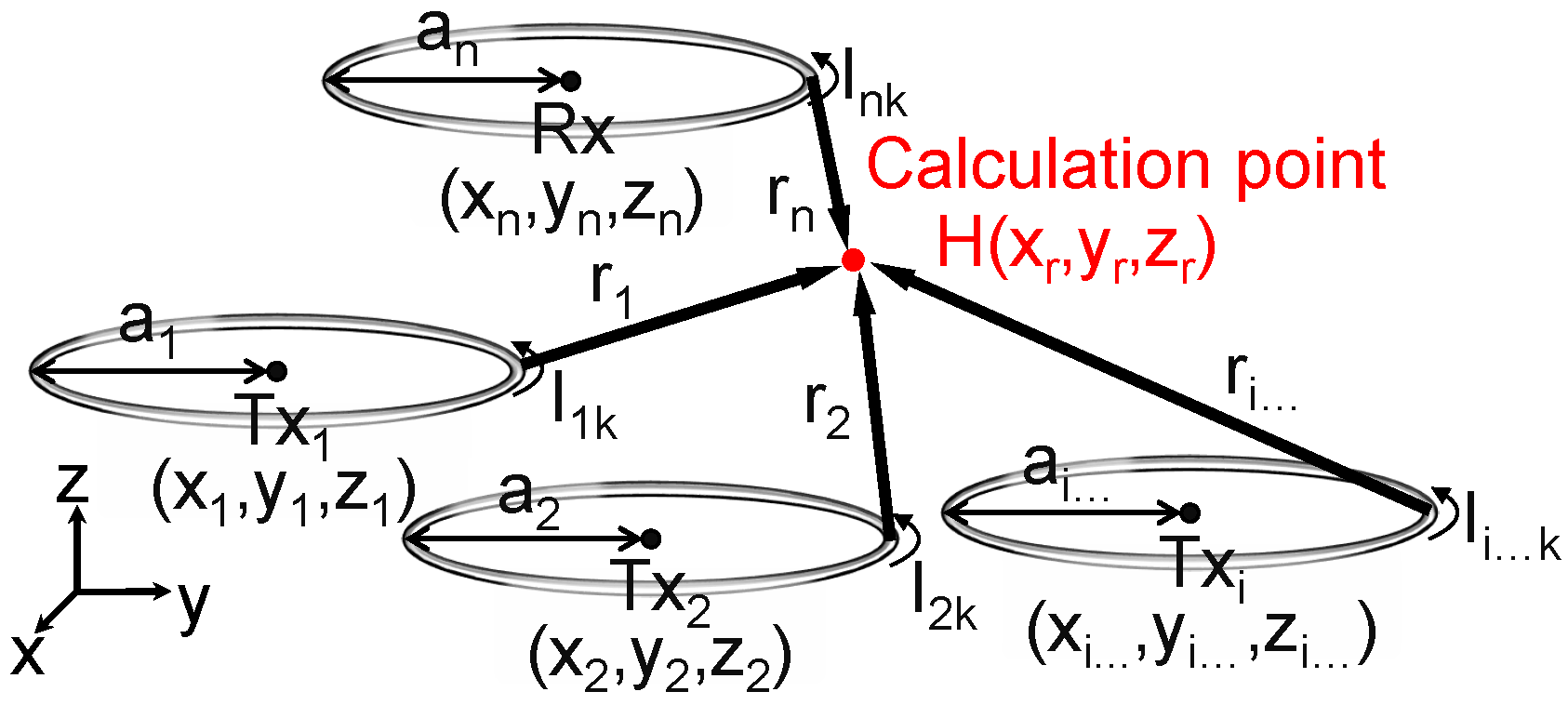


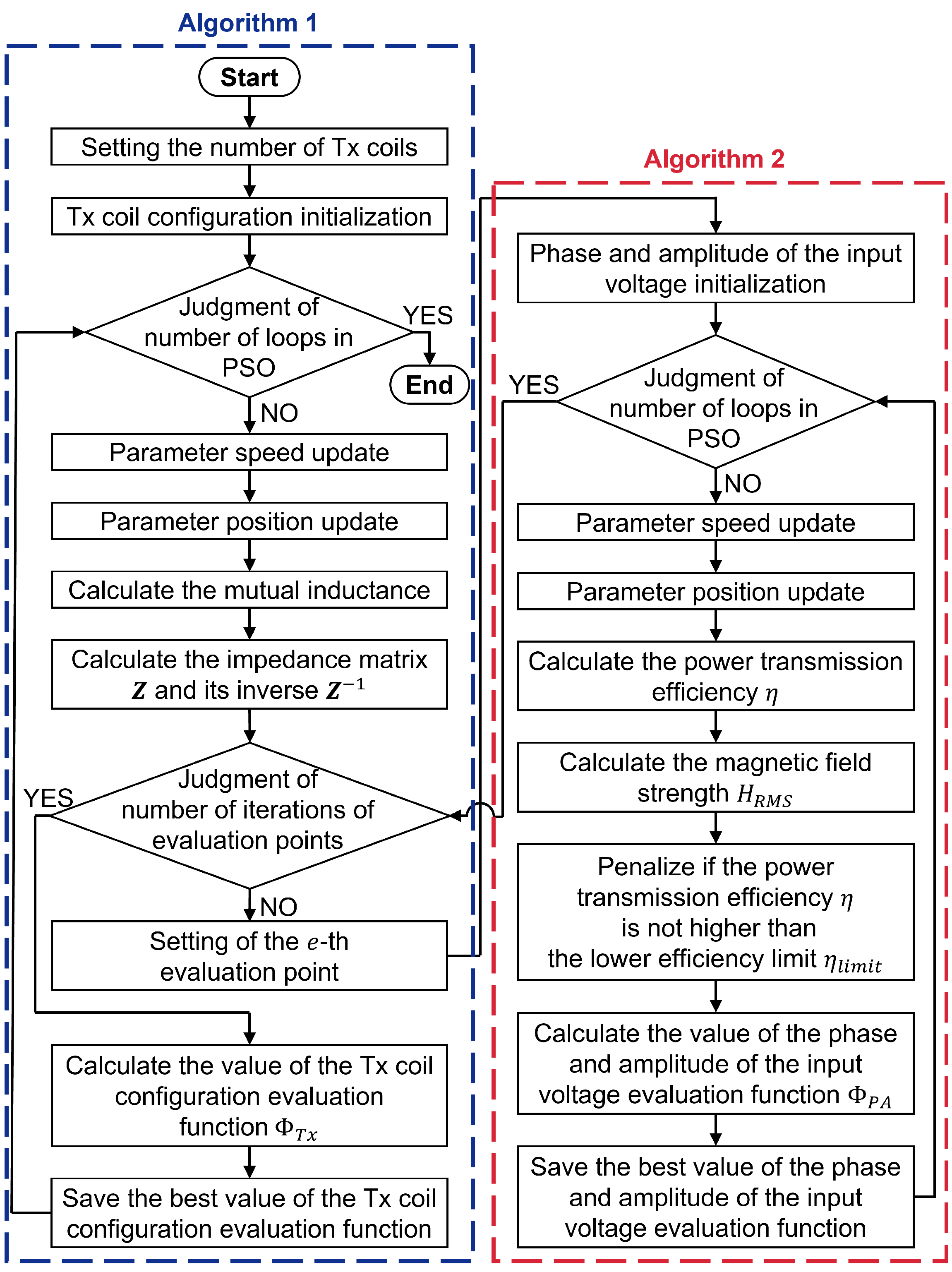

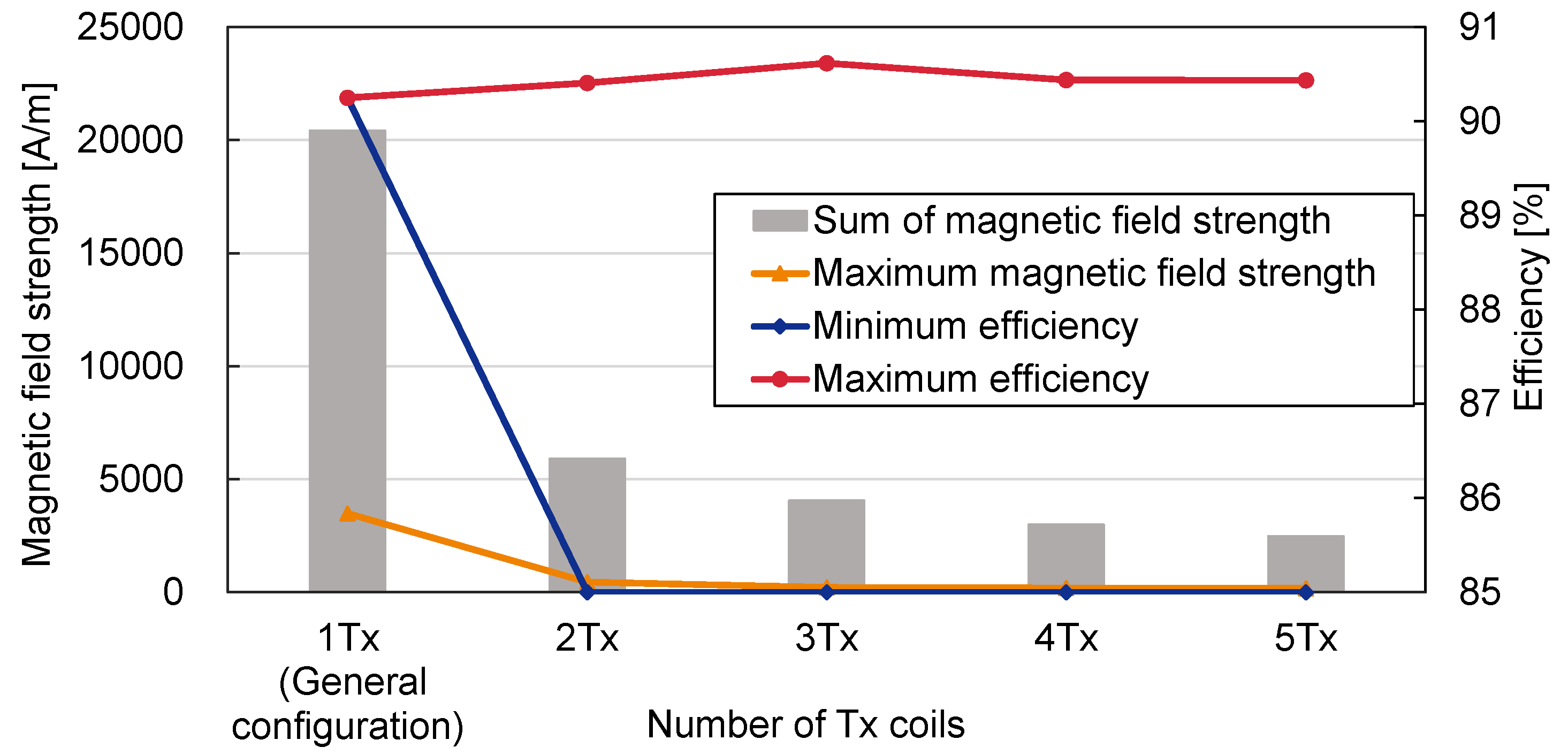
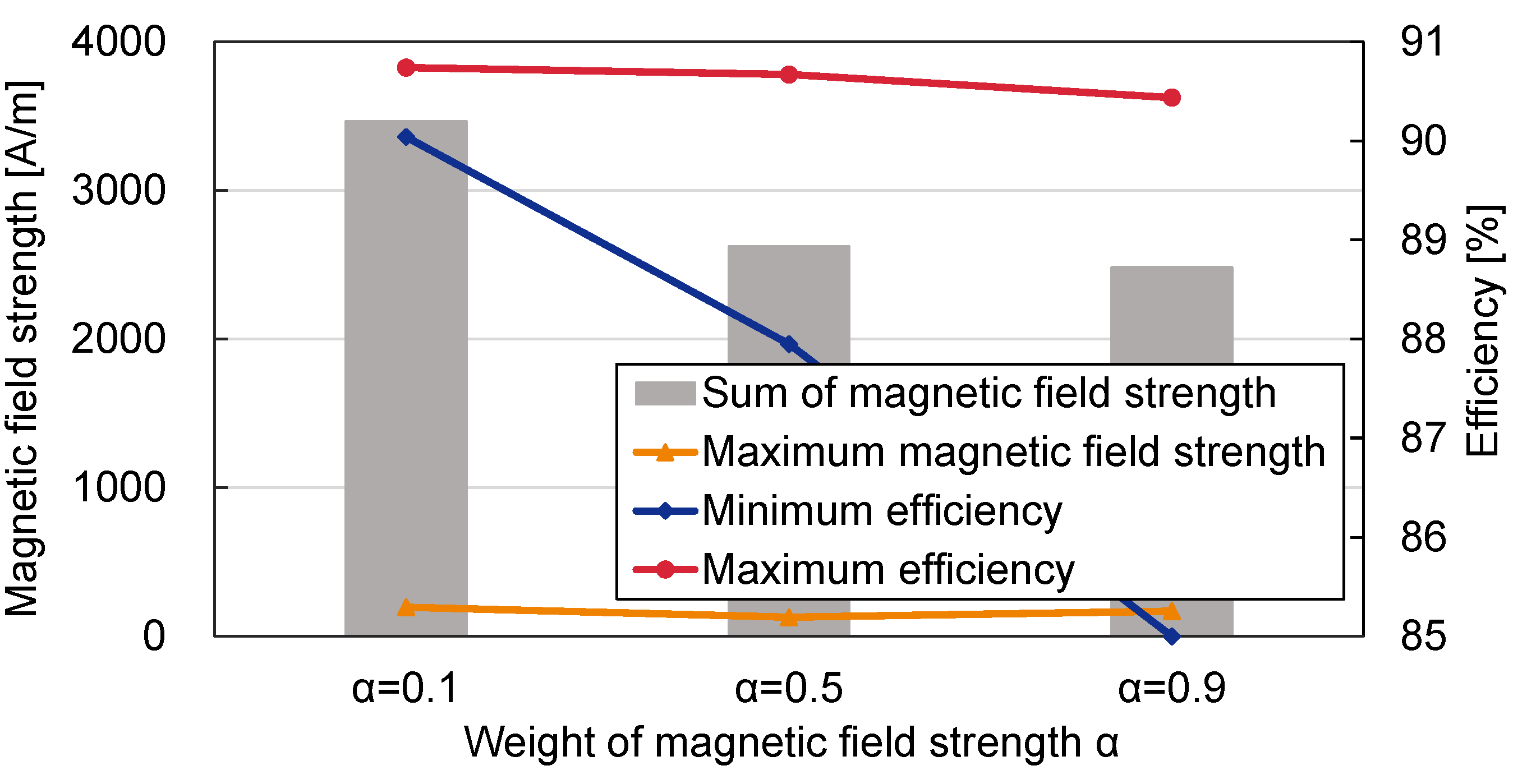

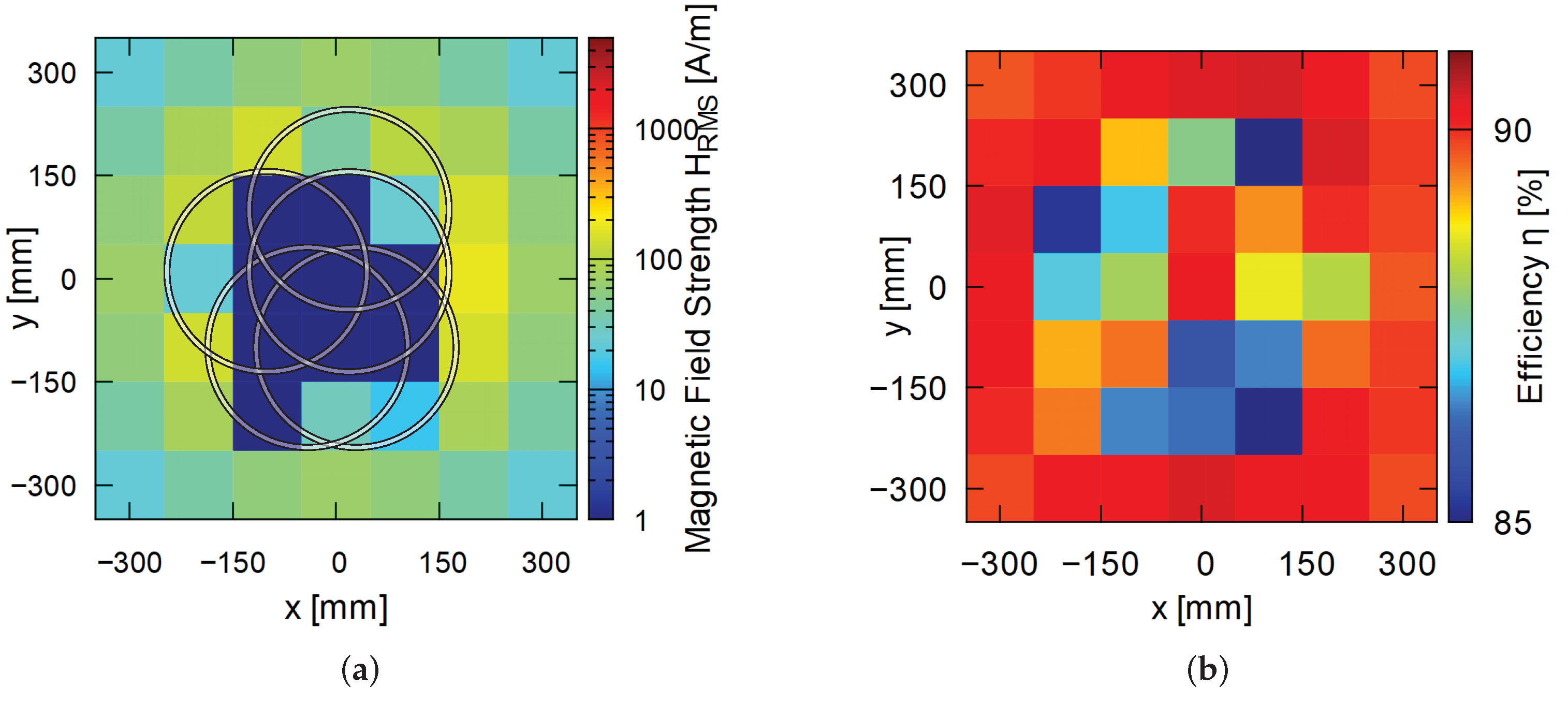
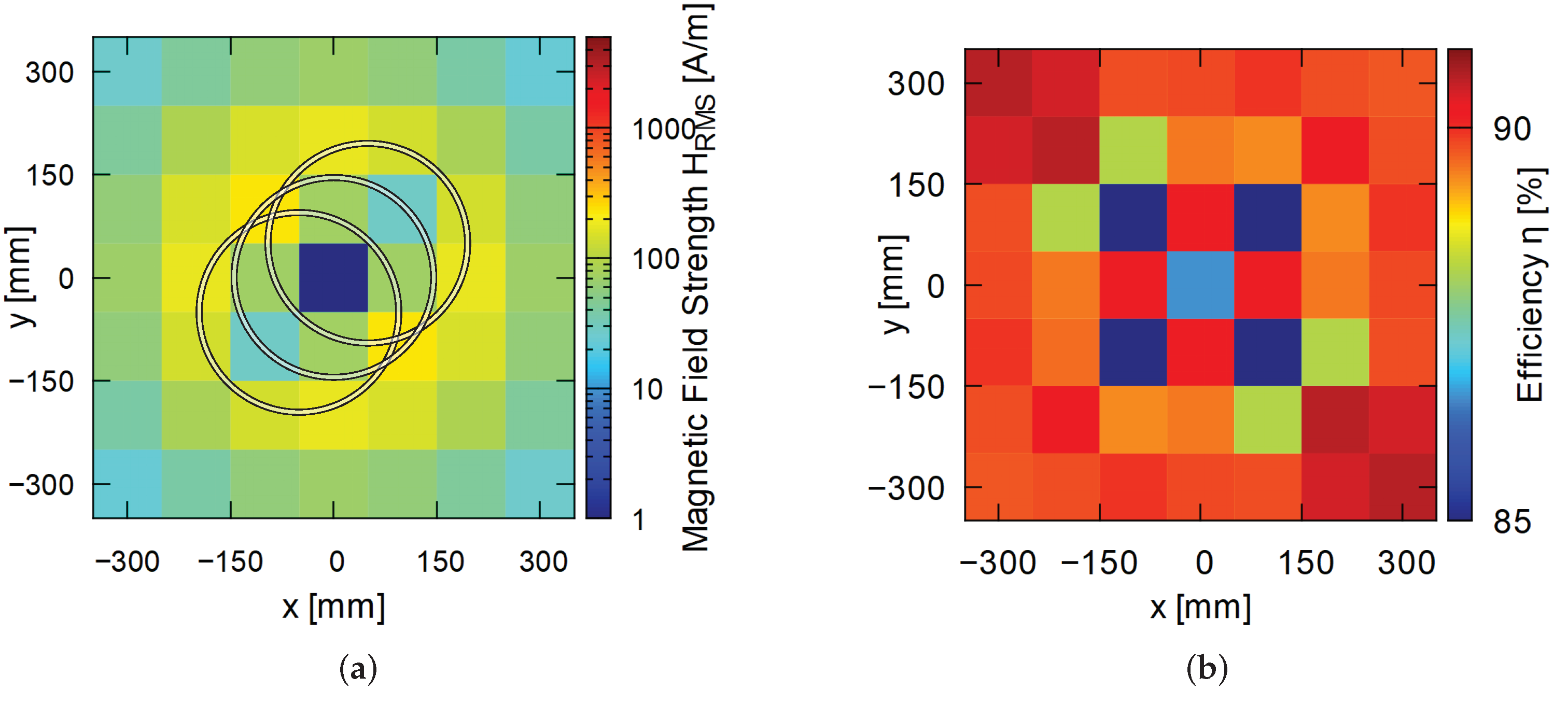

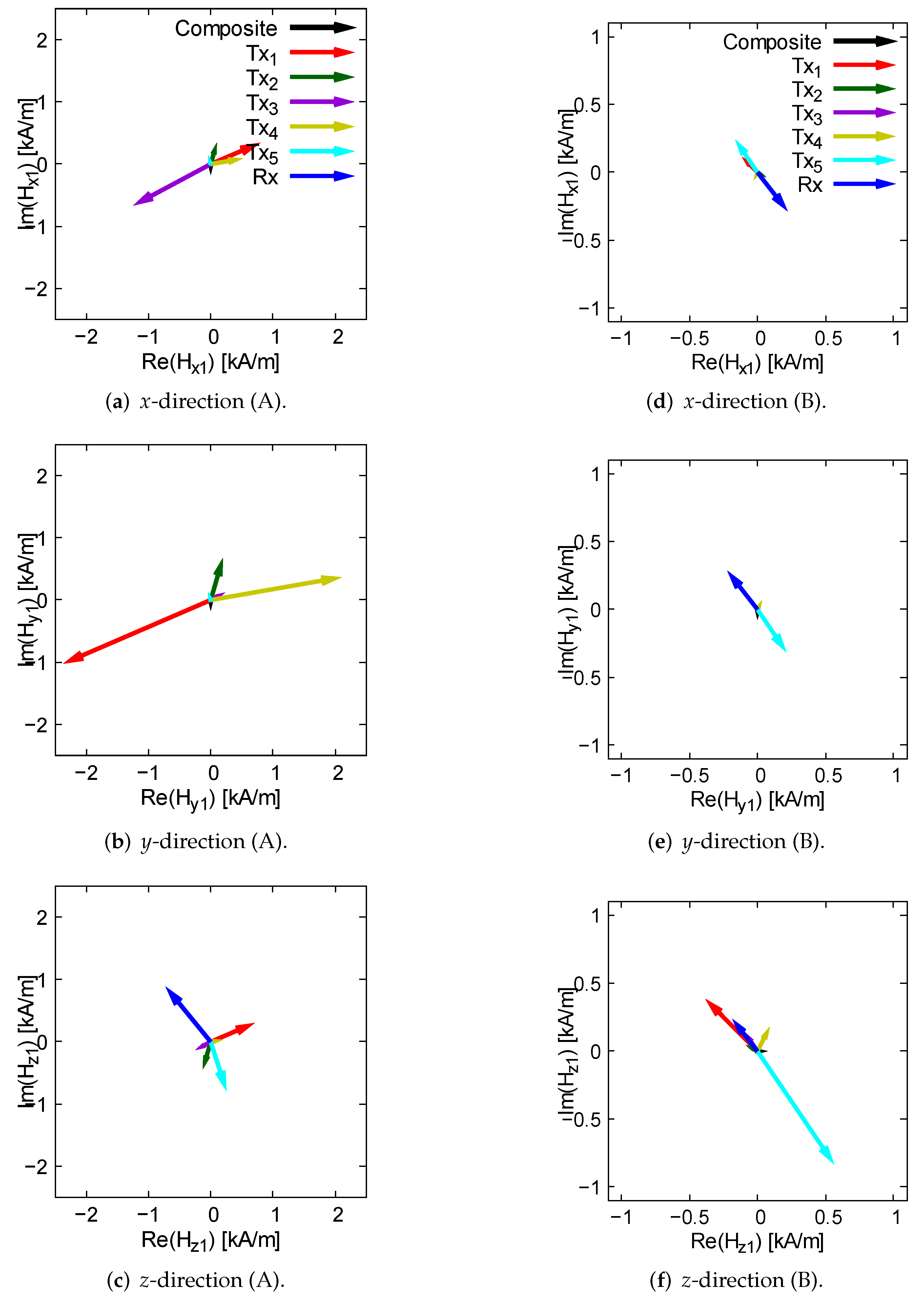
| Focusing the Magnetic Field | Selective Power Transfer | This Study | |||||||
|---|---|---|---|---|---|---|---|---|---|
| References | [17] | [18] | [19] | [20] | [21] | [22] | [23] | [24] | – |
| Number of Tx coils | 2 | 3 | 2 | 5 | 2 | 4 | 10 | 10 | 2–5 |
| Dimensions of the Tx coil array | 3D | 3D | 1D | 2D | 1D | 1D | 1D | 1D | 2D |
| Magnetic field suppression in the surrounding space | yes | yes | yes | yes | no | no | no | no | no |
| Magnetic field suppression at single point | no | no | no | no | yes | yes | yes | yes | yes |
| The point where magnetic field should be suppressed | – | – | – | – | definite | definite | definite | definite | indefinite |
| Magnetic field suppression at any point in the 2D plane | – | – | – | – | no | no | no | no | yes |
| Parameter | Value | Dimension |
|---|---|---|
| Grid spacing of the Tx coil configuration plane | 10 | mm |
| Side length of the Tx coil configuration plane | 200 | mm |
| Grid spacing of the evaluation plane | 100 | mm |
| Side length of the evaluation plane | 600 | mm |
| Evaluation plane height | 10 | mm |
| Tx–Rx Gap | 150 | mm |
| Frequency f | 85 | kHz |
| Coil material (copper wire) | 1.3 × | H/m |
| Coil radius a | 150 | mm |
| Coil turn N | 70 | turn |
| Coil resistance R | 5 | |
| Coil inductance L | 2.0 | mH |
| Coil capacitance C | 1.7 | nF |
| Coil Q-value | 213 | |
| Load resistance | 50 | |
| Load power | 11 | kW |
| Lower transmission efficiency limit | 85 | % |
| Number of Tx coils | 2–5 | number |
| Weight between magnetic field strength and power transmission efficiency | 0.1, 0.5, 0.9 | |
| Weight for normalization | 1000 |
| Parameter | Value | |
|---|---|---|
| Coil Configuration | Phase and Amplitude | |
| Number of particles | 200 | 200 |
| Number of loops | 300 | 200 |
| Maximum inertia | 0.6 | 0.6 |
| Factor | ||
| Minimum inertia | 0.3 | 0.3 |
| Factor | ||
| Weighting factor | 2.0 | 1.0 |
| Weighting factor | 1.5 | 1.7 |
| Coordinates of Evaluation Point (mm) | Transmission Efficiency (%) | Magnetic Field Strength (A/m) | Tx1 (mm) (30, −100, 0) | Tx2 (mm) (−40, −100, 0) | Tx3 (mm) (−100, 10, 0) | Tx4 (mm) (20, 100, 0) | Tx5 (mm) (20, 10, 0) | |||||
|---|---|---|---|---|---|---|---|---|---|---|---|---|
| Phase (Degree) | Amp (V) | Phase (Degree) | Amp (V) | Phase (Degree) | Amp (V) | Phase (Degree) | Amp (V) | Phase (Degree) | Amp (V) | |||
| (−200, 200, 10) | 90.2 | 78.8 | 257.1 | 3094 | 247.8 | 3406 | 259.4 | 2956 | 239.5 | 2837 | 237.8 | 2712 |
| (−200, 0, 10) | 87.0 | 22.4 | 276.3 | 3842 | 128.1 | 202 | 304.6 | 3079 | 336.2 | 2715 | 277.2 | 3897 |
| (−200, −200, 10) | 89.4 | 76.6 | 184.0 | 3822 | 276.4 | 2055 | 196.3 | 3779 | 211.4 | 2686 | 209.0 | 2454 |
| (0, 200, 10) | 87.7 | 38.9 | 274.8 | 4446 | 252.0 | 1934 | 273.8 | 4546 | 222.9 | 2939 | 256.4 | 2097 |
| (0, 0, 10) | 90.3 | 5.0 × | 224.3 | 1778 | 273.3 | 3473 | 246.1 | 2265 | 256.9 | 1557 | 250.3 | 4740 |
| (0, −200, 10) | 86.3 | 30.0 | 207.2 | 1346 | 296.5 | 1066 | 201.3 | 4166 | 320.7 | 46 | 236.0 | 5848 |
| (200, 200, 10) | 90.4 | 79.1 | 328.2 | 3248 | 336.0 | 3034 | 315.9 | 2491 | 325.3 | 2498 | 310.0 | 3451 |
| (200, 0, 10) | 88.2 | 170.3 | 320.3 | 3187 | 287.0 | 3880 | 278.7 | 2116 | 277.7 | 4799 | 359.9 | 2586 |
| (200, −200, 10) | 90.1 | 78.4 | 186.0 | 2107 | 124.6 | 3066 | 153.9 | 2011 | 144.7 | 2898 | 139.3 | 3320 |
Publisher’s Note: MDPI stays neutral with regard to jurisdictional claims in published maps and institutional affiliations. |
© 2022 by the authors. Licensee MDPI, Basel, Switzerland. This article is an open access article distributed under the terms and conditions of the Creative Commons Attribution (CC BY) license (https://creativecommons.org/licenses/by/4.0/).
Share and Cite
Sato, S.; Nakamura, S. Proposal of Wireless Charging Which Enables Magnetic Field Suppression at Foreign Object Location. Energies 2022, 15, 1028. https://doi.org/10.3390/en15031028
Sato S, Nakamura S. Proposal of Wireless Charging Which Enables Magnetic Field Suppression at Foreign Object Location. Energies. 2022; 15(3):1028. https://doi.org/10.3390/en15031028
Chicago/Turabian StyleSato, Shunta, and Sousuke Nakamura. 2022. "Proposal of Wireless Charging Which Enables Magnetic Field Suppression at Foreign Object Location" Energies 15, no. 3: 1028. https://doi.org/10.3390/en15031028
APA StyleSato, S., & Nakamura, S. (2022). Proposal of Wireless Charging Which Enables Magnetic Field Suppression at Foreign Object Location. Energies, 15(3), 1028. https://doi.org/10.3390/en15031028






